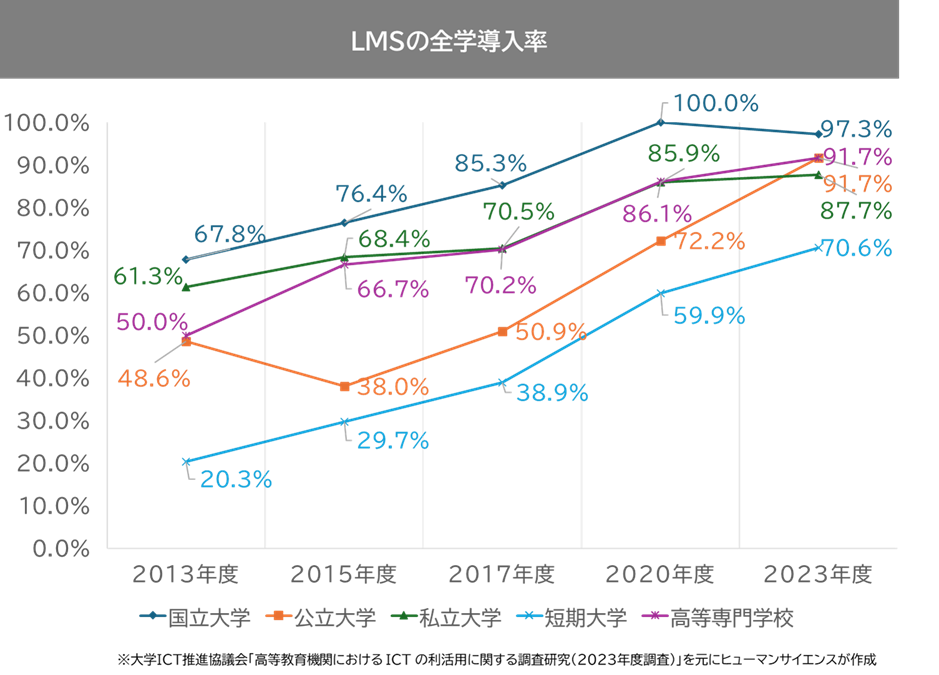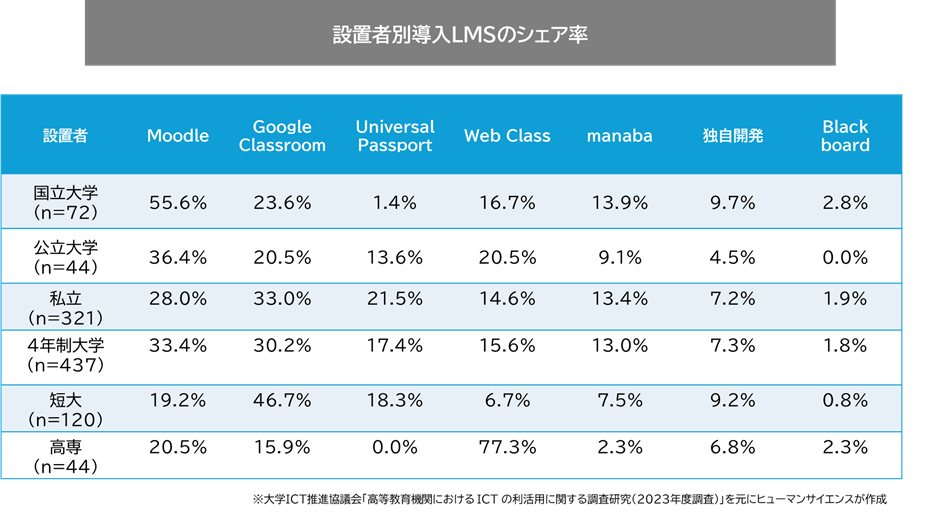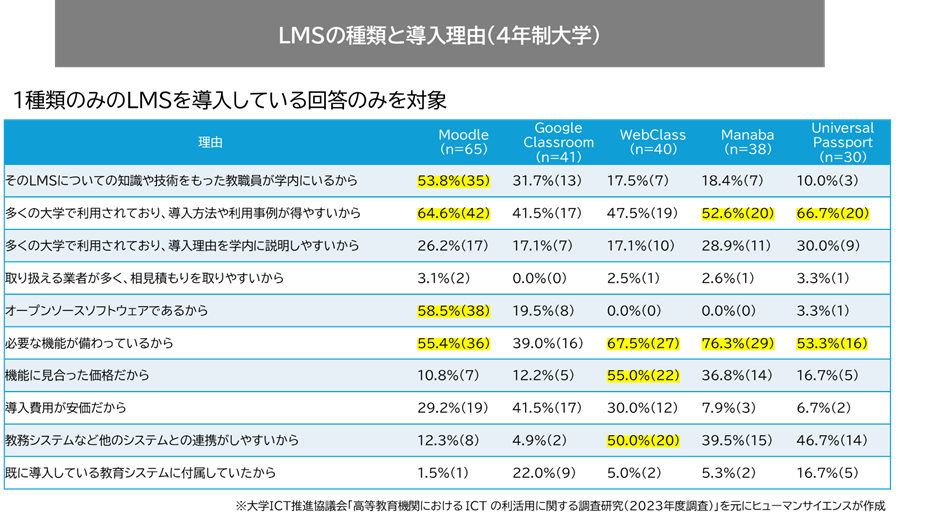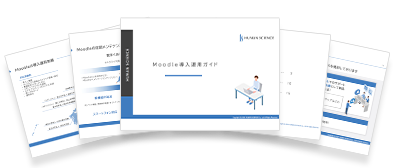2025.10.22
What LMS is Chosen by Universities? Key Points for Selection Based on Domestic Market Share and Moodle Use Cases

In university education, LMSs are now widely utilized as essential infrastructure supporting course management. Among them, Moodle is the most widely adopted LMS in universities across Japan, chosen by many universities for its flexibility and functionality. (Source: University ICT Promotion Council, "Survey Research on ICT Utilization in Higher Education Institutions (2023 Survey)"). This article introduces the reasons why Moodle is selected and examples of its operation based on the adoption status and market share of LMSs in domestic universities.
Table of Contents
1. Digitalization of University Education and the Importance of LMS
1-1. What is an LMS (Learning Management System)?
1-2. Benefits of LMS Implementation for Educational Management
2. What LMSs Are Chosen by Universities? Comparison of Major LMSs
2-1. LMS Adoption Rate in Universities in Japan
2-2. LMS Market Share in Universities in Japan
3. What is Moodle, the Most Used LMS in Japanese Universities?
3-1. Features of Moodle
4. The LMS "Moodle" Chosen by Universities: High Evaluation Seen from Reasons for Adoption and Use Cases
4-1. Benefits of Moodle Adoption Seen from LMS Selection Reasons
4-2. Moodle Use Case|[The Open University of Japan] Implementing a Bulk Course Information Registration Function in Highly Extensible Moodle to Reduce Staff Burden and Human Errors
4-3. [University of Aizu] Revamping Personalized Script Operations and Improving Maintenance of Complex Course Designs!
5. Summary
1. Digitalization of University Education and the Importance of LMS
1-1. What is an LMS (Learning Management System)?
LMS (Learning Management System) is an IT system used by educational institutions to streamline classes and learning activities and support learners' education. Specifically, it provides necessary functions for educational activities online, such as distributing class materials, submitting and grading assignments, managing grades, attendance tracking, and conducting tests.
In traditional face-to-face classes, the distribution of paper-based materials and verbal instructions were central, but with the introduction of LMS, all these tasks can now be completed online. Especially since 2020, triggered by the COVID-19 pandemic, online classes and hybrid classes (a combination of face-to-face and online) have rapidly spread in university education settings, leading to a sudden surge in demand for LMS.
Nowadays, LMS is positioned not merely as a "convenient tool" but as infrastructure for university education. It can be said that LMS is indispensable for accommodating students' diverse learning styles and providing flexible learning that is not constrained by time or place.
1-2. Benefits of Introducing LMS in Educational Administration

Introducing an LMS brings many benefits to university educational administration. First, for instructors, it streamlines class preparation and grade management, and since they can monitor students' learning status in real time, early follow-up becomes possible.
For students as well, the convenience of learning is greatly improved because checking and submitting class materials and assignments can be completed online. An environment accessible anytime from smartphones or PCs allows them to study at their own pace, unaffected by commuting time or lifestyle.
In addition, the learning history accumulated in the LMS plays an important role in quality assurance of education and internal quality assurance efforts. The guidebook published by the Ministry of Education, Culture, Sports, Science and Technology also indicates that "visualization of educational quality" using learning history is effective for educational improvement, and the LMS is expected to serve as the foundation for this.
> Reference link: Ministry of Education, Culture, Sports, Science and Technology Guidebook on Data Collaboration and Utilization for Improving the Quality of Education
Furthermore, LMS also offers benefits to university IT departments in terms of system integration and security management. By choosing an LMS that can integrate with external tools such as Zoom, Google Classroom, and Office365, compatibility with existing IT environments can be enhanced, reducing the operational burden on the university.
As such, LMSs hold value as strategic tools that contribute not only to the educational field but also to improving the overall operational efficiency and educational quality of universities.
2. What LMSs Are Chosen by Universities? Comparison of Major LMSs
2-1. LMS Adoption Rate in Universities in Japan

The above table was created based on the Current Status and Prospects of ICT Utilization in Higher Education Institutions – Results from the 2023 Survey – ICT Utilization Survey Subcommittee_2023 Survey_Report (Preliminary)_Appendix.pdf.
Many universities have introduced LMSs following the COVID-19 pandemic, but what is the actual adoption rate?
This graph shows the status of university-wide LMS implementation and operation at universities in Japan, based on the "Survey Research on ICT Utilization in Higher Education Institutions (2023 Survey)" conducted by the University ICT Promotion Council (AXIES).
From the graph, it can be seen that the adoption rate has increased across almost all categories from fiscal year 2013 to fiscal year 2023, and LMS has been introduced in most universities. In particular, national universities have implemented LMS at a rate of 100% in fiscal year 2020, up from 67.8% in fiscal year 2013. Similarly, private universities have seen a significant increase from 61.3% to 87.7%, and public universities have also progressed with an adoption rate of 91.7%.
The rapid spread of this adoption has been greatly influenced by the expansion of the novel coronavirus infection since 2020. Due to restrictions on face-to-face classes, the shift to online classes became urgent, and the introduction of LMS was promoted regardless of the size or type of university. As a result, LMS has come to be widely used as a foundation to ensure the continuity and flexibility of education.
2-2. LMS Share in Universities in Japan
LMS services range from those developed domestically in Japan to those developed overseas. What kinds of LMS are most commonly used in Japan?
Similarly, the University ICT Promotion Council (AXIES) conducted the "Survey Research on the Utilization of ICT in Higher Education Institutions (2023 Survey)," which shows the share of LMS used by universities in Japan categorized by their founding bodies.

According to the survey, the open-source LMS "Moodle," which is also used worldwide, is widely utilized with a share of 55.6% in national universities, 36.4% in public universities, and 28.0% in private universities.
Following that, Google Classroom provided by Google is also widely used. Due to the rapid shift to online learning during the COVID-19 pandemic, Google Classroom, which can be easily started, is often used in conjunction with other LMSs.
Additionally, Universal Passport has a 21% adoption rate in private universities.
3. What is Moodle, the most widely adopted LMS in universities across Japan?

Moodle is an open-source LMS originating from Australia, with its first version released in 2002. It is widely used by educational institutions worldwide and, as previously mentioned, is implemented in about 56% of national universities in Japan.
So, why is Moodle chosen so widely? The reason lies in its design philosophy that closely supports educational settings and its flexible operability.
3-1. Features of Moodle
・Open source and freely customizable
Moodle is provided as open source, so there are no licensing fees. A major appeal is that functions can be freely added or modified to suit each university’s educational policies and system environment. Flexible operation that is difficult with other LMSs becomes possible, such as integration with proprietary authentication systems and campus portals. If there is a system capable of technical support, it can also lead to long-term cost reduction.
・Rich Features Designed for Educational Institutions
Moodle comes standard with all the features necessary for university education. Assignment submission, tests, forums, attendance management, grade management, group work, and other essential elements for class management can all be handled on a single platform. It is used by more than 480 million educators and students worldwide (as of September 24, 2025), and its features are continuously expanded and improved based on user needs and feedback.
・High Extensibility and Abundant Plugins
Moodle has over 2,000 plugins available, allowing you to add features as needed. For example, extensions can be made to meet the needs of educational settings such as video streaming, external tool integration, learning analytics, and surveys. Plugins are developed and improved by educator communities worldwide, which is also a strength that enables Moodle to always keep up with the latest educational trends.
>What types of Moodle plugins are there?
・Global Track Record and High Security
Moodle is a global LMS used in over 200 countries and supports more than 200 languages. It is equipped with robust security features designed specifically for educational institutions, enabling necessary measures for protecting on-campus information such as user authentication, access control, data encryption, and log management. Thanks to regular updates and improvements by developers worldwide, it can be considered a highly reliable LMS that can be operated with peace of mind.
>[Moodle Basic Course] Moodle Security Measures
4. LMS "Moodle" Chosen by Universities: High Evaluation Seen from Reasons for Adoption and Use Cases
Moodle is a reliable LMS designed for educational institutions, equipped with abundant features and high extensibility, and is used worldwide. So, what are the reasons Moodle is chosen by universities in Japan? From here, we will take a closer look at the background of LMS selection in universities and the reasons for adopting Moodle.
4-1. Benefits of Moodle Implementation Seen from LMS Selection Reasons
The University ICT Promotion Council (AXIES) conducted the "Research on the Utilization of ICT in Higher Education Institutions (2023 Survey)," which also presents survey results regarding the reasons universities choose LMSs when implementing them.

According to this survey, Moodle is often chosen for reasons such as "there are already people within the institution who are familiar with it" and "it is used by many universities." This is because Moodle is widely used worldwide and also within Japan, making it highly likely that there are knowledgeable staff members on campus, and numerous case studies and operational know-how from other universities are abundantly available on the internet.
In addition, since Moodle is provided as open source, it is highly attractive because it can be flexibly customized to fit each university's educational policies and system environments. Given its proven track record of use in educational institutions worldwide, it encompasses all the necessary functions for educational settings, and the expectation of stable operation after implementation is also frequently cited as a reason for its selection.
4-2. Moodle Use Case|[The Open University of Japan] Reducing Staff Burden and Human Errors with Highly Extensible Moodle
The Open University of Japan operates approximately 85,000 learners and about 250 courses. Manually setting up as many as 250 courses by administrators required an enormous amount of time and posed a risk of human errors. By leveraging Moodle’s flexible structure, they newly developed a function to register course information in bulk, significantly reducing the risks of missed settings and human errors that had been problematic.
>For detailed case studies of The Open University of Japan, see here:
[The Open University of Japan Case Study ①] The Open University Web Learning System and Distance Guidance
[The Open University of Japan Case Study ②] Comprehensive support system ensuring stable operation of the Moodle system
4-3. [Aizu University] Revamping Personalized Script Operations to Improve Maintainability of Complex Course Designs!
At Aizu University, Moodle has been implemented university-wide since the 2019 academic year to accommodate complex class structures. Course design requires flexible adaptation to the university’s unique enrollment patterns, such as the mix of lectures and exercises and operation of subjects across multiple classes. To address these challenges, the system was reviewed leveraging Moodle’s high customizability and extensibility, achieving integration with enrollment data and automation of academic year adjustments.
>For detailed case studies of Aizu University operations, see here:
[Aizu University Case Study] Revamping personalized script operations to ensure reliable Moodle management.
5. Summary
As digitalization of university education progresses, LMS has become an essential infrastructure supporting not only the educational field but also the entire university administration. Among them, Moodle is highly regarded for leveraging the flexibility and extensibility unique to open source, enabling it to meet the complex requirements of each university. Its high market share is proof of its achievements, and case studies show that it contributes to operational efficiency and improvement in the quality of education.
However, because Moodle is open source, there are many situations where specialized knowledge and skills are required if you try to manage everything solely within your own organization. In particular, experience and know-how are indispensable for handling version upgrades, integrating with other systems, and establishing a stable operational framework.
Based on our extensive support experience in Moodle implementation and operation, we provide optimal support tailored to each university's environment. If you are responsible for LMS stability or operational challenges, please feel free to contact us.
>Moodle Implementation Support
Moodle Related Information
- 2025.10.29
- [Moodle Manual ⑤] 2025 Edition|Support Staff Explain How to Set Up and Utilize Groups/Groupings!
- 2025.10.28
- Can You Obtain Qualifications Through e-Learning? Examples of Qualifications and Their Benefits













